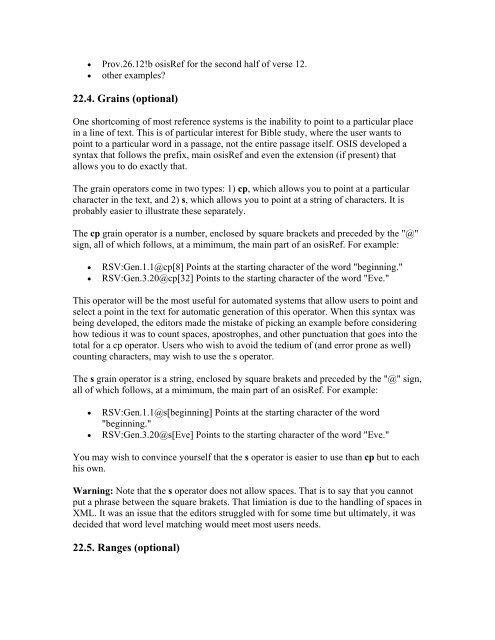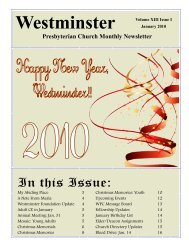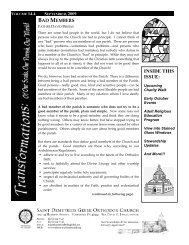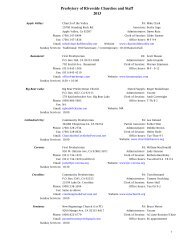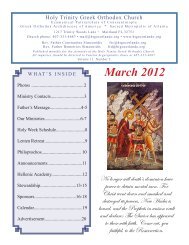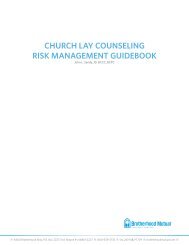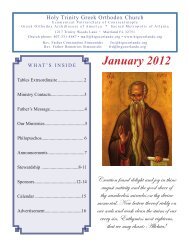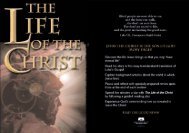OSIS? 2.0.1 User's Manual - Web services are running on AMBIB
OSIS? 2.0.1 User's Manual - Web services are running on AMBIB
OSIS? 2.0.1 User's Manual - Web services are running on AMBIB
Create successful ePaper yourself
Turn your PDF publications into a flip-book with our unique Google optimized e-Paper software.
• Prov.26.12!b osisRef for the sec<strong>on</strong>d half of verse 12.<br />
• other examples?<br />
22.4. Grains (opti<strong>on</strong>al)<br />
One shortcoming of most reference systems is the inability to point to a particular place<br />
in a line of text. This is of particular interest for Bible study, where the user wants to<br />
point to a particular word in a passage, not the entire passage itself. <str<strong>on</strong>g>OSIS</str<strong>on</strong>g> developed a<br />
syntax that follows the prefix, main osisRef and even the extensi<strong>on</strong> (if present) that<br />
allows you to do exactly that.<br />
The grain operators come in two types: 1) cp, which allows you to point at a particular<br />
character in the text, and 2) s, which allows you to point at a string of characters. It is<br />
probably easier to illustrate these separately.<br />
The cp grain operator is a number, enclosed by squ<str<strong>on</strong>g>are</str<strong>on</strong>g> brackets and preceded by the "@"<br />
sign, all of which follows, at a mimimum, the main part of an osisRef. For example:<br />
• RSV:Gen.1.1@cp[8] Points at the starting character of the word "beginning."<br />
• RSV:Gen.3.20@cp[32] Points to the starting character of the word "Eve."<br />
This operator will be the most useful for automated systems that allow users to point and<br />
select a point in the text for automatic generati<strong>on</strong> of this operator. When this syntax was<br />
being developed, the editors made the mistake of picking an example before c<strong>on</strong>sidering<br />
how tedious it was to count spaces, apostrophes, and other punctuati<strong>on</strong> that goes into the<br />
total for a cp operator. Users who wish to avoid the tedium of (and error pr<strong>on</strong>e as well)<br />
counting characters, may wish to use the s operator.<br />
The s grain operator is a string, enclosed by squ<str<strong>on</strong>g>are</str<strong>on</strong>g> brakets and preceded by the "@" sign,<br />
all of which follows, at a mimimum, the main part of an osisRef. For example:<br />
• RSV:Gen.1.1@s[beginning] Points at the starting character of the word<br />
"beginning."<br />
• RSV:Gen.3.20@s[Eve] Points to the starting character of the word "Eve."<br />
You may wish to c<strong>on</strong>vince yourself that the s operator is easier to use than cp but to each<br />
his own.<br />
Warning: Note that the s operator does not allow spaces. That is to say that you cannot<br />
put a phrase between the squ<str<strong>on</strong>g>are</str<strong>on</strong>g> brakets. That limiati<strong>on</strong> is due to the handling of spaces in<br />
XML. It was an issue that the editors struggled with for some time but ultimately, it was<br />
decided that word level matching would meet most users needs.<br />
22.5. Ranges (opti<strong>on</strong>al)


